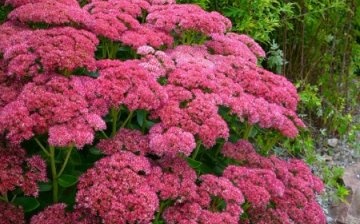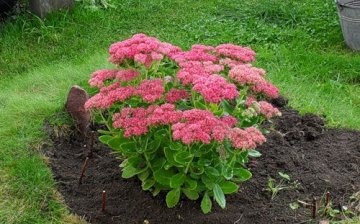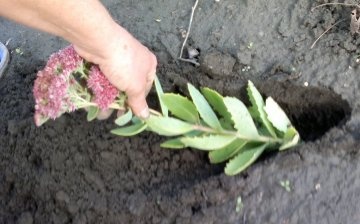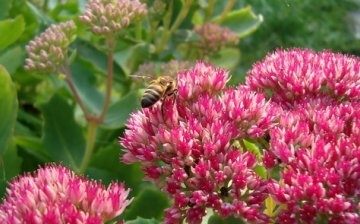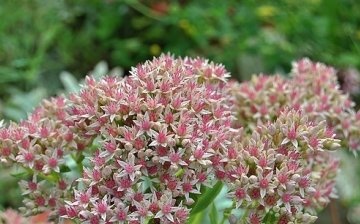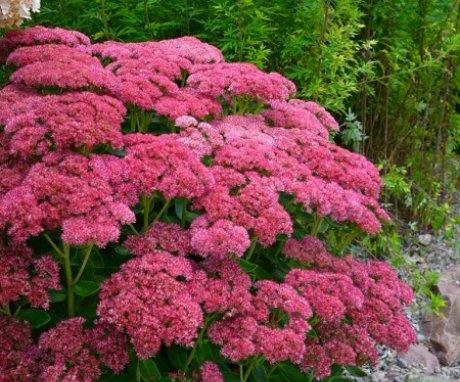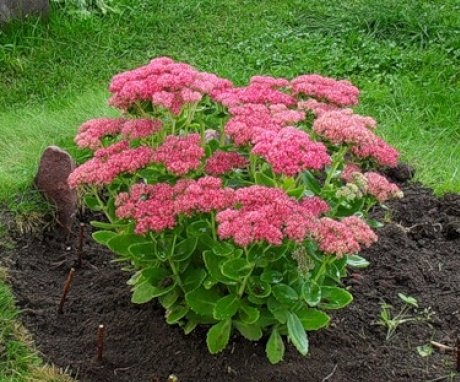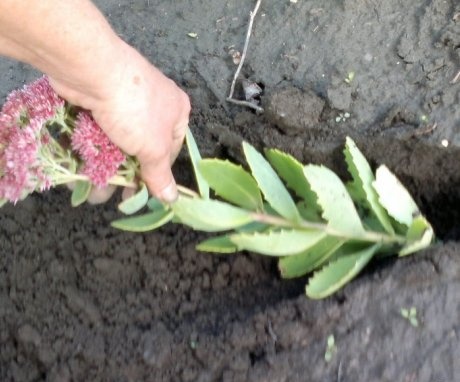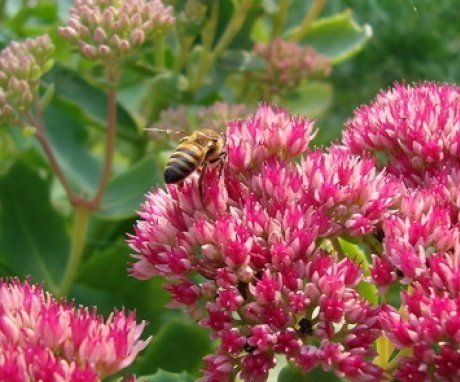Sedum prominent: characteristic features, types and agricultural technology
Sedum is the Russian name for the Sedum plant. This plant has more than 600 species and subspecies in the world. Perennial frost-resistant, delighting with its juicy green leaves and bright flowers, collected in inflorescences. These are the most late flowering plants from the Tolstyankov family.
Content:
- General information about sedum
- Description of sedum prominent
- Plant propagation
- Useful properties of sedum
- Sedum varieties
General information about sedum
With the arrival of late autumn, with the appearance of regular frosts, the garden changes its appearance. Bright familiar colors fade, and the tone is set by those plants that do not care about coolness and low temperatures. Usually these plants are faded and inconspicuous. But among them there is a place for bright colors.
They are the ones that delight the eye during the "dull pores" period. It is incredible, but with the help of some plants it is possible to prolong the visibility of summer in the garden. Sedums are winter-hardy plants. Many gardeners and florists grow stonecrops on a par with asters, physalis, chrysanthemums and crockworms, planting them around the perimeter of the flower beds.
The most common sedum is prominent or remarkable sedum.
Features of sedum:
- Its origin originates from the countries of the East: China, Japan, Korea.
- Under natural conditions, the plant grows in gorges, on the edges of pine forests, along roads. This plant is often called hare cabbage and youthful.
- During the flowering period, the plant forms chic tapestries of lush inflorescences.
- They are wonderful honey plants that attract the last butterflies and bees to the autumn garden. Stonecrop honey is a healing agent. It is delicious and very healthy.
These plants are often used to camouflage unattractive places on a personal plot: vacant lots, gardening, buildings. These flowers give the site the appearance of a complete design solution, a feeling of well-groomed. Often this plant can be seen in city flower beds, where it frames lawns, flower beds, flower beds.
The sedum is an excellent partner plant for the anterior and midline.
Description of sedum prominent
Botanical description of the plant:
- The sedum is prominent - bush plant, forming bushy shoots with a height of 30 to 60 centimeters.
- It has a tuberous thickened root.
- The stem is juicy, erect.
- The stems have flat oval leaves. They are quite large and juicy, 3-4 pieces are collected in whorls. Their color is from pale green to dark gray.
- This plant pleases its owners from September to November with bright flowering.
- The flowers are small, collected in large inflorescences up to 20 centimeters in diameter. The variety of shades ranges from cream to bright carmine. Most often there are varieties with a pink-lilac color of flowers.
- The flowering period depends on the climatic conditions of growth, usually from 30 to 40 days.
The prominent sedum feels great on moist fertile soil. Not afraid of shadows, but prefers open, bright places. A sunny location is an important condition for the full growth of a wonderful sedum. Only under the rays of the sun do the flowers acquire richness and fullness of color, and the leaves become juicy and dense.The shade causes this plant to quickly fade and turn pale.
With warm autumn and bright days, stonecrop can bloom even in November. And for a while, the plant can continue to bloom even under the snow.
An important condition for the full and successful cultivation of stonecrop are: good drainage and regular weeding. The plant does not require special fertilizers, dressing. Enough fertile soil, compost or humus.
This plant is drought-resistant, but during the growth of the sedum requires abundant watering. In this case, stagnant water should be avoided, since high soil moisture can lead to root rot. And rotten roots is the death of a plant.
Plant propagation
There are several ways sedum propagates:
- Seeds.
- Stems.
- Cuttings.
- By dividing.
The easiest and most reliable breeding method for stonecrop is prominent. Every 5 years, the plant is planted, divided. The optimal seating time is spring. At the same time, the curtain is carefully cut. When dividing, each part must have roots, buds, shoots.
The plant reproduces by seeds only in breeding.
Usually sedum after such sowing in the first year is small, capricious. Seedlings give rise only after a long time: from 30 to 120 days. The seedlings are small; for strengthening and productive growth, a pick is required after the leaves appear on the stems. Seedlings dive into garden soil, preferably into boxes. The resulting germinated seedlings are then planted in the ground at a distance of 20 centimeters.
Sedum cuttings:
- When grafting, the stem itself is cut into pieces no more than 5 centimeters long.
- The cuttings are then planted in special places.
- This is usually best done in greenhouses and conservatories. But there are cases when broken stems of a plant, falling into the ground, germinated.
- Rooting occurs on day 7.
The wonderful sedum is quite resistant to diseases and pests.
This plant suffers little from disease. Sometimes this species infects aphids. With this pest, insecticides designed for black currant... Rarely stonecrop affects thrips, as evidenced by the curved tops of the plant. Sometimes large leaves are gnawed by a furrow-winged elephant. This weevil infects the leaf edge of the plant at night, and its larvae damage the roots.
Useful properties of sedum
There are many popular names for sedum:
- Skripun.
- Fever grass.
- Hare cabbage.
- It was rejuvenated.
- Hare grass.
- Hernial grass.
- Tenacious.
- Breakout.
- Live grass.
Oh healing properties this plant was already known to Hippocrates. The plant was used as a wound healing, antibacterial, pain reliever. Sedum treats many diseases, helps to alleviate the general condition of the patient.
Thus, Dioscorides and Pliny mentioned sedum in their manuscripts as a plant for the treatment of the wounded. They used the plant to treat fractures and burns. In folk medicine, not only plant sap is used. Both leaves and stems are used.
No wonder the plant got the name sedum (from the purifier), with the help of it warts and calluses were removed.
Sedum extract is a biostimulant along with aloe. By infusion, evaporation and straining, you can prepare the extract at home.
There is a belief that the plant removes lightning from buildings. In this regard, in ancient times in Germany, a plant was planted on the uppermost rows of fortresses and on the roofs of houses. Therefore, in Germany, the plant was called fortress.
The sedum is used in modern folk medicine for the following diseases:
- Ischemic heart disease, in the chronic course of the disease.
- Heart failure.
- Pulmonary insufficiency.
- Anemia.
- Diseases of the liver and gallbladder.
- Diseases of the gastrointestinal tract.
The plant sap tones and strengthens the body. It is recommended to use it during the treatment of critically ill patients. It is used in the form of poultices, compresses, rubbing, infusions, ointments, extracts, decoctions.Stonecrop is contraindicated in people with oncological diseases of various etiologies and with anacidic and hypocidal gastritis.
The main thing is not to confuse stonecrop with a poisonous plant, caustic stonecrop.
Sedum varieties
Sedum has many varieties and subspecies. But all varietal plants are more capricious than their parental species.
The growth of unusual varieties should be monitored, especially those with unusual leaves. If "wild" green shoots are found, pluck them out. Otherwise, soon the whole bush will turn green.
The most popular varieties of stonecrop are:
- Diamond. It is a large perennial plant with thick roots and a straight stem 50 centimeters high. Leaves are bluish-green, serrated. The flowers are bright pink. It is characterized by late flowering.
- Charles. A perennial plant with a stem height of 50 centimeters. Leaves are bluish-green, oval, serrated. Flowers - carmine pink, in corymbose inflorescences, large. Frost resistant.
- Star Dust. The plant is of medium height (35 centimeters) with thick shoots and large blue-green leaves. The flowers are creamy and white, collected in inflorescences. The plant blooms until the frost, starting in August.
- Iceberg. The plant is tall, succulent, with snow-white flowers.
- Variegatum. Has distinctive yellow leaves and flowers.
- Bright. Succulent plant with glowing, bright pink flowers in large inflorescences.
- Carmen. The plant is very tall with bright red flowers.
- Matron. It has a short stature, dark leaves and light pink flowers in inflorescences.
In the last period, new varieties of stonecrop have been developed in Holland:
- Xenox. The plant is not tall, but peculiar. Has a dark purple stem, the same leaves and red-purple flowers. The height of this variety is 30 centimeters.
- Ash Emperor. This variety is similar to Xenox, but the color of the whole plant is several tones lighter. Plant height 45 centimeters.
- Diamond Edge. Low plant. It has light pink flowers and green foliage with cream interspersed along the edge.
- Frosty Morn. An elegant and peculiar plant. It has an average stem height - up to 40 centimeters. The flowers are pale white. The foliage is bicolor: white and green.
All this splendor of the species, its diversity is capable of autumn turn any garden into an enchanting picture... This plant is often used in composing compositions for a Japanese garden. It is appropriate to use sedum in a design solution for a hedge. Sedum fits well among low-growing plants on "alpine lawns".
For amateurs and professionals of landscape and decorative art, sedum is good both in flower beds, and in curbs, and in rocky gardens, and on slopes.
This flower fits well into the countryside and the landscape of chic, wealthy mansions.
More information can be found in the video.




